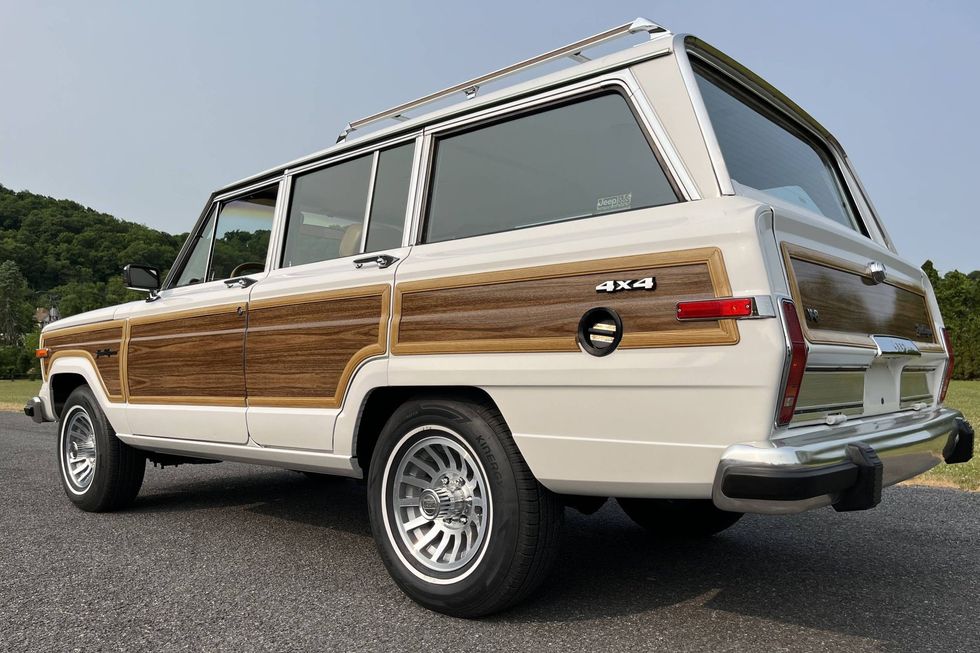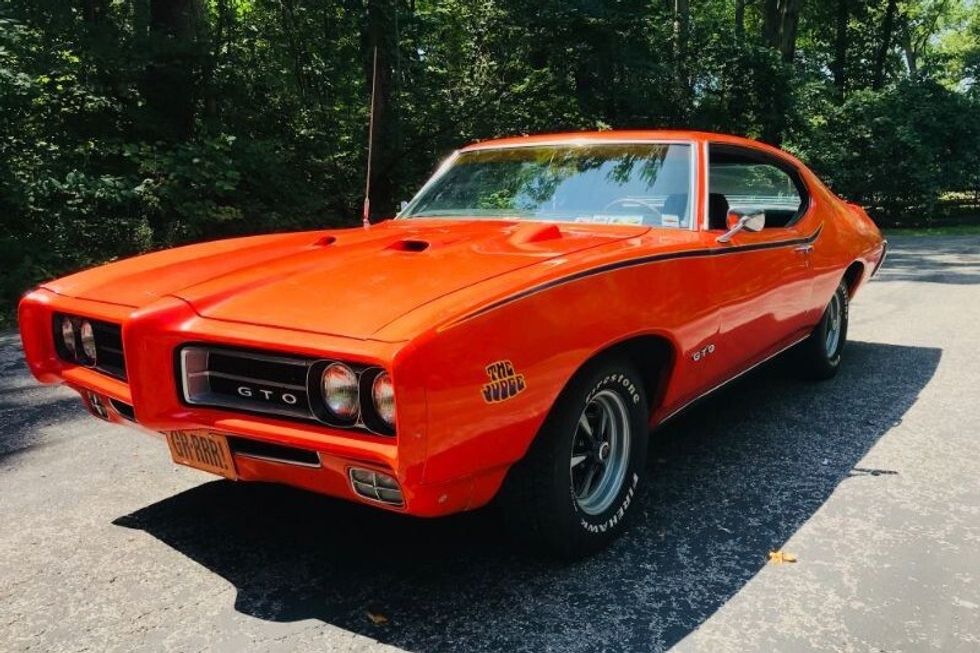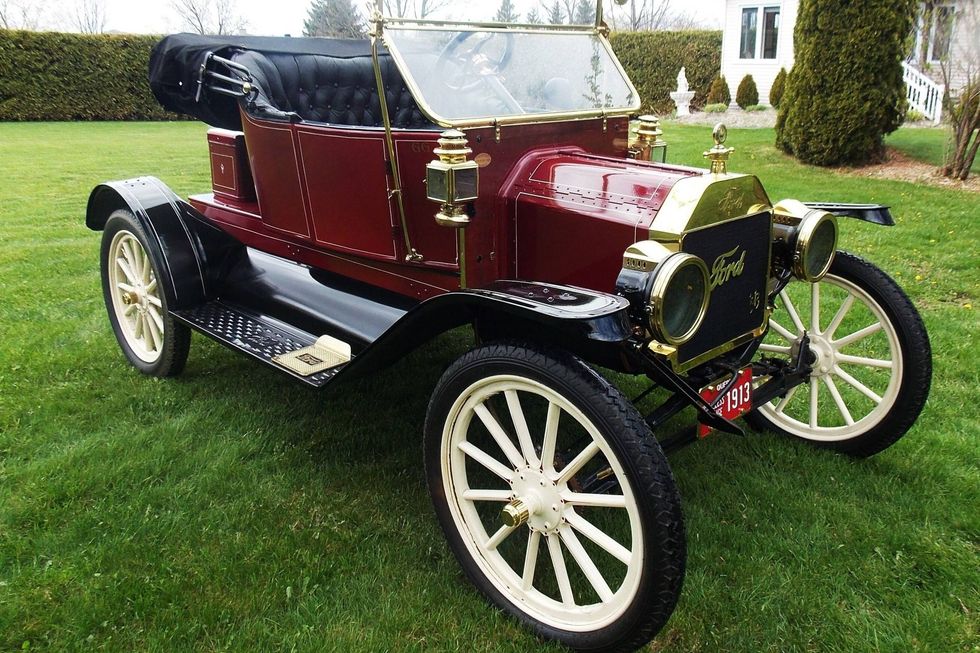Stately Strength - 1952 Chrysler Saratoga
With its unmatched power-to-weight ratio, the 1952 Saratoga was Chrysler's middleweight champion
09/23/2018


The 1951 Chrysler Saratoga was a car in the center of an all-new lineup packed with Chrysler Corporation technological firsts. Ventilated drum brakes joined optional Hydraguide power steering. The semi-automatic Fluid Drive transmission was updated to Fluid-Matic and Fluid-Torque. But the big news for the model year 1951 was an all-new engine: the 331-cu.in. Chrysler V-8 with overhead valves and a hemispherical-shaped combustion chamber. In the Saratoga, this V-8 made more horsepower than the top-of-the-line Cadillac or Oldsmobile engines. In fact, with an almost 40hp advantage over the Cadillac, the FirePower hemi was the engine to have under the hood.
More good news was that the Saratoga was not only available with this 180hp V-8, but by virtue of the car featuring a body fixed atop underpinnings from the low-line Windsor, it was the fastest car in the Chrysler fleet--faster, even if not by much, than the top-of-the-line New Yorker. The over-square engine, with a cylinder bore wider than the piston stroke, created greater than one-half horsepower per cubic inch of displacement--a number unequalled by competitors in 1952. Tipping the scales at 250 pounds less than the higher-end luxury New Yorker, the svelte Saratoga was the middleweight champion in the 1952 Chrysler lineup.
Pulling into the gas station with the Saratoga didn't mean having to fill up on high test. The hemi engine's 7.5:1 compression ratio meant regular gas would work just fine. Meanwhile, the mechanical updates were the important ones: The 1952 Chrysler Saratoga remained largely unchanged from the 1951 model, save for an integrated backup lamp within the taillamp assembly. Steel shortages, due in part to a strike and a country in the midst of the Korean War, called for nationwide austerity measures, and this meant that Chrysler's 1951-'52 model year ran for 18 months, more or less. Saratoga, in all its guises, sold a total of 45,500 units, with 35,516 of the total production run built as four-door sedans.

With its subdued outward appearance that belied the nearly 200hp lurking beneath the hood, and a historical significance in the hemi kingdom, the Saratoga stands as a solid performer even today.

The car is an early production example of the subsequent trend of installing powerful engines in an unlikely platform; in its very essence, it was an early muscle car. Due to its combination of understated looks and excellent performance at the right price, the Saratoga was a hit with horsepower-happy customers, hot rodders and stock car racers alike; its excellent power-to-weight ratio alone made it a favorite. Weighing under 4,000 pounds in two-door coupe form, the Saratoga was the performance bargain of 1951, and was still a bargain for Dave Katen some 30 years later.
Dave found his Chrysler Saratoga in a Connecticut barn in 1983. By his own admission, the good-humored native New Yorker (now living in Milford, Connecticut) is not a car guy in the conventional sense. Dave just likes driving. However, Dave had a few pals who were car guys back in the early Eighties.
Rather than making an exhaustive search for his 1952 Saratoga, therefore, the car found Dave back in 1983. A friend was painting an old barn in Westport, Connecticut, and called Dave at the office to tell him that there was "some old car out here in the barn." Since the barn was only five minutes from Dave's office, out he went. A cash deal was made on the spot. "Remember," Dave said, "there were no ATMs back then. The guy said he wanted $600 dollars. I said I didn't have $600 dollars. So he said, give me $400."
Dave subsequently called upon the tireless servicemen of AAA, as his new acquisition would not start. The tow truck dropped the car off at Dave's house, and he and a pal made like Aladdin, polishing and cleaning to conjure up the hemi genie back out of the blackened lamp. "It was there in the barn for 20 years. A friend of mine who knows something about cars cleaned it up, and put Marvel Mystery Oil in the engine. It turned over. He said 'Now we gotta take it apart and clean it,' but it turned okay," said Dave.

The engine proved to be in sound shape, with no disassembly required. With some cleaning and a new battery, the old hemi, with a mere 54,000 miles logged, breathed fire once again. One of Dave's employees used a long-forgotten potion to bring the original green paint back to a mostly original appearance. All this was good news to Dave, who likes driving a heck of a lot more than spinning wrenches or running rags around.
The semi-automatic transmission was a source of great mystery for Dave, who drove the Saratoga around in first gear until finding a book that spelled out how to operate the transmission with three pedals on the floor. At a dead stop, the clutch is depressed and released like a manual transmission--but only in first gear from a stop. Second gear arrives automatically by letting off the gas pedal for the shift.
"I'm being truthful when I say I didn't know how to drive it. I wasn't the only one, though. Every one of my big-mouthed friends would get in and say, 'I know how to drive a clutch,' and I would say, 'Okay, good. Get in. Go ahead.' Then they got in and saw on the steering column, Reverse, Neutral and Drive--and didn't know what to do. They got out of the car because they couldn't do anything. It was hysterical. Absolutely hysterical."
Once everything was mechanically sorted out, Dave bought four new tires. The modern radials with glue-on whitewalls didn't quite work out, so he turned to Hemmings Motor News for some original-size and -style tubeless replacements. The problem was that Dave noticed the tubeless tires would lose air. "I had original hubcaps. I had everything, but never changed the rims. They said my tires were going down because my rims needed replacing. I wasn't going to change the rims, so I had tubes put in the tubeless tires, and they never lost air again."
The plush interior of the car is original except where a mouse chewed up through the front seat. Dave had the driver's side reupholstered, but thankfully, the rest of the car was free of rodent destruction. Meant for families and daily use, the Saratoga has plenty of room for six adults, possibly more. "I know you could fit at least six," Dave said. "However, the rear floor was at 45 degrees. So you could sit and put your feet up, which was nice. You could really relax. It's like a couch. And with the mohair upholstery, oh yeah, it's really nice."
Dave's stately looking sedan came equipped with the optional heater, but no radio. Dave located a correct stock radio and antenna and installed it in place instead of the factory radio-delete plate. Today, Dave takes it to drive-ins and many car shows, taking home a few awards in the process, and having a lot of fun while doing it.
Dave doesn't worry too much about maintenance routines, preferring to follow the "if it ain't broke, don't fix it" philosophy of car repair. What did he do to get the car ready to go out? "I checked the oil, and the oil was fine. The water was fine. So now I take it out and just drive it. Of course, it still goes. I'd be driving it and I'd say, 'Hm. I'm hitting 80 MPH, and then I'd say, 'What am I, stupid?!' and then I'd back off.
"Now, I'm doing 60 MPH on I-95 in the middle lane heading to a car show and I'm thinking: 'Why would I mess with this car?' You know what I mean? I'm not a car person. I put the key in the ignition. If it starts, fine. If it doesn't, I call AAA."
The British motor industry is well represented on this week’s round up of successful sales on Hemmings.com. The strongest listing went to an LS V8-powered 1997 Land Rover Defender 110 custom that outperformed the market and looked to be able to well outperform a stock 110. A 1978 Aston Martin AM V8 found a new home via auction, the same fate experienced by a V12-powered 1972 Jaguar XKE Series 3 roadster. The original Jeep Grand Wagoneer was perhaps the first luxury SUV and the 1988 example sold on Hemmings.com featured low-mileage and excellent overall condition. There are few muscle cars are instantly recognizable as a Carousel Red Pontiac GTO Judge, like the 1969 model detailed below. Finally, we look at a restored 1913 Ford Model T Runabout sold from a Canadian-based collection.
For the week of May 12 through May 18, a total of 61 listings crossed the Hemmings Auctions block. Including Make Offer listings of previously ended auctions, a total of 40 cars were sold, resulting in a net 66% sell-through rate. An additional 29 cars were sold via direct Make Offer listings.
You can keep abreast of the latest consignments by subscribing to the daily Hemmings Auctions email newsletter.

Reserve: $80,000
Selling Price: $84,000
Recent Market Range: $45,000-$80,000
Aston Martin produced some version of its V8-powered saloon from 1969 through 1989, though we are more likely to refer to the body style as a coupe on this side of the Atlantic. A beefy 5.3-liter DOHC V8 with multiple carburetors and a stout Chrysler-sourced TorqueFlite automatic very much gave the models a muscle car vibe, albeit one made with fine leather upholstery and thick wool carpets. This silver on red 1978 Aston Martin AM V8 Series III saloon, which traded hands last year via online auction for $46,988, achieved one of the highest prices seen in recent years for a coupe equipped with a standard-specification engine, particularly outside the U.K., where values are typically stronger.

Reserve: $63,000
Selling Price: $68,775
Recent Market Range: $54,000-$75,000
Perhaps no other American vehicle has combined class and off-road capability quite like the original Grand Wagoneer, the trailblazing luxury SUV that was produced by Jeep for almost three decades. This 1988 Jeep Grand Wagoneer was submitted with just 27,417 miles showing on the odometer and plenty of notes from the seller indicating the original condition of the vehicle and all of its major components. The undercarriage, interior and engine bay photos all appeared to show an exceptionally clean example, which is notable for a rust-prone vehicle that has been in the Northeast since new. The net sale price, achieved with the 39th bid, was in line with market expectations for this very collectible vehicle.

Asking Price: $150,000
Selling Price: $157,500
Recent Market Range: $80,000-$150,000
The Land Rover Defender market shows no signs of slowing down, particularly as more and more examples are allowed into the U.S. via the DOT’s 25-year rule for previously banned imports. Likewise, there is a burgeoning market for what can best be described as restomodded examples, like this 1997 Land Rover Defender 110, which was powered by a modern GM LS3 V8, the same powerplant found in later C6 Corvettes. The list of what was original to this SUV might be shorter than what was changed, given the comprehensive nature of the build. Achieved via a direct Make Offer listing, the net sale price of this Land Rover was at the very top end of recent market activity for such customized Defenders.

Reserve: $54,000
Selling Price: $52,500
Recent Market Range: $46,000-$62,000
This 1969 Pontiac GTO Judge ticked all the right boxes: matching numbers with photos verification of the partial VIN stamping on the engine block of the original Ram Air III V8, Muncie four-speed manual transmission, PHS documentation, and that classic Carousel Red finish and Judge decals. It looked to be in excellent overall condition, but it also appeared to have been driven and enjoyed some in recent years, with some signs of wear. And the net sale price, achieved via post-auction Make Offer listing, reflected the condition and authenticity of the car. A concours-level example, or one with a rare Ram Air IV engine for example, would likely command a premium over this one.

Reserve: $65,000
Selling Price: $69,825
Recent Market Range: $78,000-$115,000
The final iteration of the Jaguar XKE was a bit larger than the original and not as precisely focused on its sporting nature. Rather, with a big V12 under the hood, it was more of a GT car. This 1972 Jaguar E-type Series III Roadster appeared to have some minor wear and tear and signs of road use, but it made up for any shortcomings with what appeared to be an abundance of authenticity. The seller noted that the exterior finish, interior upholstery and engine were all original. Reflecting the low number of owners and the car’s years sitting in a museum, the odometer reading of just over 30,000 miles was also believed accurate. While the net sale price was below market expectations, it was not too far off.

Reserve: $25,00
Selling Price: $26,250
Recent Market Range: $22,000-$36,000
There has never been a shortage of early Fords at Hemmings, dating to the earliest days of our magazine. Like any other vehicle, the most desired examples in the best condition will always attract the bidders. This 1913 Ford Model T Runabout appeared to have been restored to high level and showed only minimal signs of use. It was also equipped with an electric starter. The maroon body, black fenders and white spoke wheels nicely complemented the button-tufted black vinyl seat. The undercarriage appeared to be exceptionally clean, indicating little use for the car that was said to come from a Model T collection. The next sale price was well within the going market rate for an open-top, two-seat, early Model T.
What was thought to be the last Chevrolet Camaro rolled out of the factory in late-2023, but the model’s nameplate may not be on hiatus for long. General Motors president Mark Reuss reportedly wants to see the Camaro make a comeback as an affordable EV.
According to Motor Trend, Reuss has a vision to create a budget-friendly four-door electric vehicle under the Camaro muscle car nameplate. The approach would be somewhat similar to Ford’s Mach-E, except instead of offering an electric crossover alongside gas-powered coupe and convertible Mustangs, the Camaro would retain its sedan body style. The future electric Camaro is unlikely to be offered in a coupe or convertible version due to engineering complications for the EV platform and low sales numbers for two-door cars, which wouldn’t justify the extra expense.
While most Americans recognize the Camaro as a burly muscle car, Reuss reportedly wants the next generation of Camaro to go back to the model’s roots as a simple and affordable vehicle.
The estimated cost for a Camaro EV sedan could be similar to the current MSRP of a Chevy Equinox EV crossover which starts at $34,995. By adding an EV Camaro to its electric vehicle lineup, Chevrolet will have several affordable EVs available in the near future, including the return of the Chevy Bolt.
Despite Reuss’s desire to re-focus the Camaro EV on practicality and affordability instead of performance and high-horsepower numbers, it’s important to note that none of this news is formally part of GM’s production plan. With nothing yet set in stone, there’s still a glimmer of hope that we may still see a next-gen Camaro with bigger performance options.